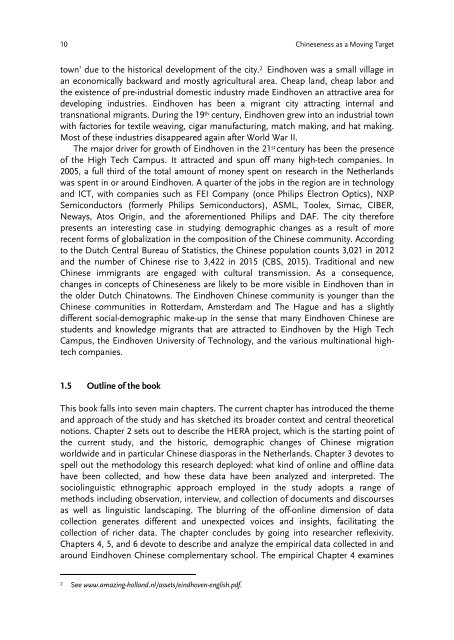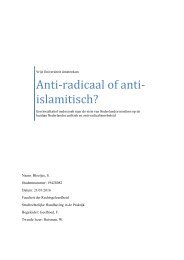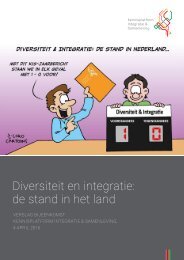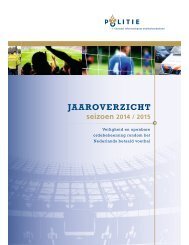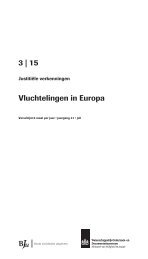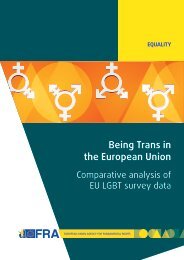Tilburg University Chineseness as a Moving Target Li Jinling
Li_Chineseness_12_09_2016
Li_Chineseness_12_09_2016
You also want an ePaper? Increase the reach of your titles
YUMPU automatically turns print PDFs into web optimized ePapers that Google loves.
10 <strong>Chineseness</strong> <strong>as</strong> a <strong>Moving</strong> <strong>Target</strong><br />
town’ due to the historical development of the city. 2 Eindhoven w<strong>as</strong> a small village in<br />
an economically backward and mostly agricultural area. Cheap land, cheap labor and<br />
the existence of pre-industrial domestic industry made Eindhoven an attractive area for<br />
developing industries. Eindhoven h<strong>as</strong> been a migrant city attracting internal and<br />
transnational migrants. During the 19 th century, Eindhoven grew into an industrial town<br />
with factories for textile weaving, cigar manufacturing, match making, and hat making.<br />
Most of these industries disappeared again after World War II.<br />
The major driver for growth of Eindhoven in the 21 st century h<strong>as</strong> been the presence<br />
of the High Tech Campus. It attracted and spun off many high-tech companies. In<br />
2005, a full third of the total amount of money spent on research in the Netherlands<br />
w<strong>as</strong> spent in or around Eindhoven. A quarter of the jobs in the region are in technology<br />
and ICT, with companies such <strong>as</strong> FEI Company (once Philips Electron Optics), NXP<br />
Semiconductors (formerly Philips Semiconductors), ASML, Toolex, Simac, CIBER,<br />
Neways, Atos Origin, and the aforementioned Philips and DAF. The city therefore<br />
presents an interesting c<strong>as</strong>e in studying demographic changes <strong>as</strong> a result of more<br />
recent forms of globalization in the composition of the Chinese community. According<br />
to the Dutch Central Bureau of Statistics, the Chinese population counts 3,021 in 2012<br />
and the number of Chinese rise to 3,422 in 2015 (CBS, 2015). Traditional and new<br />
Chinese immigrants are engaged with cultural transmission. As a consequence,<br />
changes in concepts of <strong>Chineseness</strong> are likely to be more visible in Eindhoven than in<br />
the older Dutch Chinatowns. The Eindhoven Chinese community is younger than the<br />
Chinese communities in Rotterdam, Amsterdam and The Hague and h<strong>as</strong> a slightly<br />
different social-demographic make-up in the sense that many Eindhoven Chinese are<br />
students and knowledge migrants that are attracted to Eindhoven by the High Tech<br />
Campus, the Eindhoven <strong>University</strong> of Technology, and the various multinational hightech<br />
companies.<br />
1.5 Outline of the book<br />
This book falls into seven main chapters. The current chapter h<strong>as</strong> introduced the theme<br />
and approach of the study and h<strong>as</strong> sketched its broader context and central theoretical<br />
notions. Chapter 2 sets out to describe the HERA project, which is the starting point of<br />
the current study, and the historic, demographic changes of Chinese migration<br />
worldwide and in particular Chinese di<strong>as</strong>por<strong>as</strong> in the Netherlands. Chapter 3 devotes to<br />
spell out the methodology this research deployed: what kind of online and offline data<br />
have been collected, and how these data have been analyzed and interpreted. The<br />
sociolinguistic ethnographic approach employed in the study adopts a range of<br />
methods including observation, interview, and collection of documents and discourses<br />
<strong>as</strong> well <strong>as</strong> linguistic landscaping. The blurring of the off-online dimension of data<br />
collection generates different and unexpected voices and insights, facilitating the<br />
collection of richer data. The chapter concludes by going into researcher reflexivity.<br />
Chapters 4, 5, and 6 devote to describe and analyze the empirical data collected in and<br />
around Eindhoven Chinese complementary school. The empirical Chapter 4 examines<br />
2<br />
See www.amazing-holland.nl/<strong>as</strong>sets/eindhoven-english.pdf.


